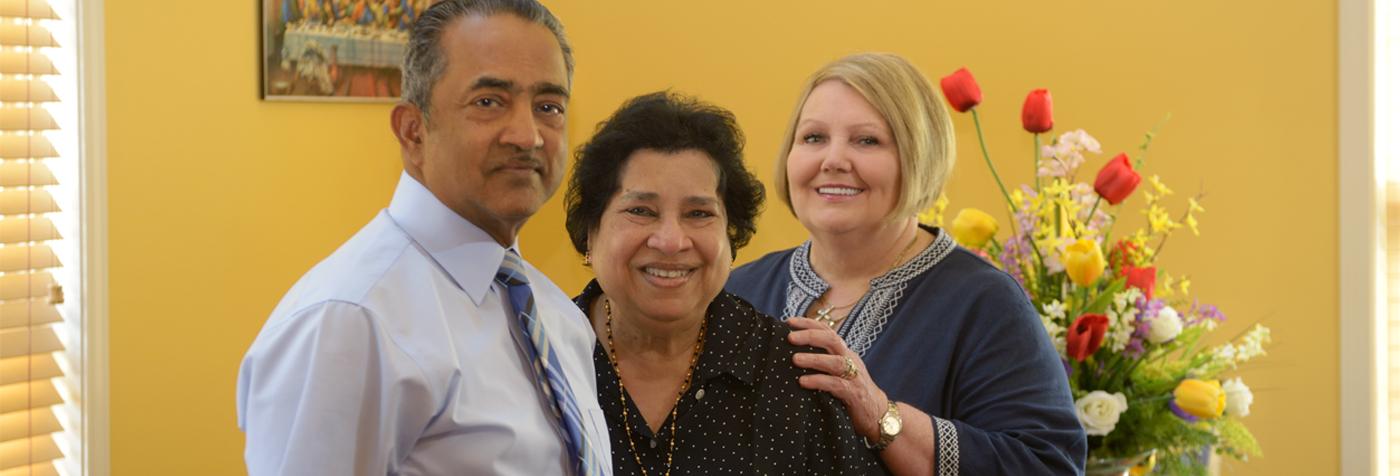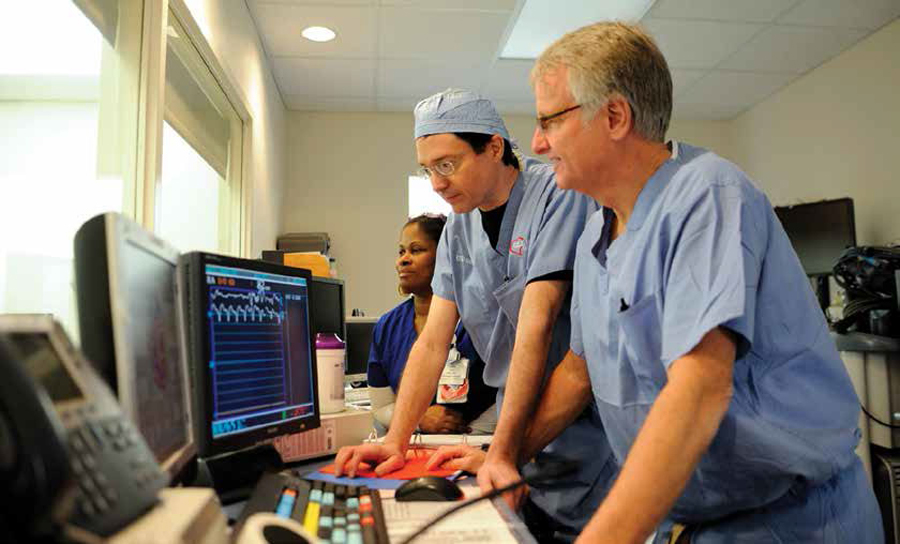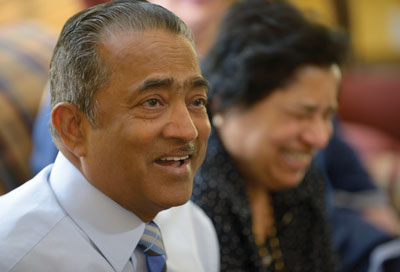Heart network relationships pay off for Kentucky physician facing his own health crisis

When faced with a crisis or medical emergency, it is common to seek the comfort and support of immediate family members and close friends. But when Roy Varghese, MD, and his wife Lilly recently faced a life-threatening medical emergency, their four daughters were all hundreds of miles and several hours away.
It was the Vargheses’ extended community family that came to their aid and comfort in those first critical hours. Today, they credit the love, prayers and support of their community and the highly skilled and timely medical care provided by ARH and UK HealthCare specialists for saving Roy Varghese’s life.
For more than three decades, Varghese has provided primary care for residents of Eastern Kentucky. Always in relatively good health, it was a bit of a surprise when the physician suddenly became a patient and nearly lost his life to a heart attack.
Physician suddenly becomes patient
After a full day of treating patients in his busy office and rounding on patients at Mary Breckinridge ARH Hospital in Hyden, Ky., Varghese headed home for dinner. He had been experiencing minimal symptoms of abdominal discomfort – much like indigestion – throughout the day. When the pain persisted through dinner, he told his wife it was time to go to the hospital.
Little did he know then how critical that timely decision would be in saving his life.
Emergency physicians at the hospital in Hyden quickly assessed Varghese, and an EKG revealed he was experiencing an acute inferior myocardial infarction (AMI), or heart attack, which occurs when blood flow stops to part of the heart causing damage to the heart muscle.
The most common symptom of an AMI is chest pain or discomfort that may travel into the shoulder, arm, back, neck or jaw. Often it is in the center or left side of the chest and lasts for more than a few minutes. Occasionally, it may simply feel like heartburn. Shortness of breath, nausea, feeling faint, a cold sweat or feeling tired may also occur.
According to Varghese, about 30 percent of people experiencing an AMI have atypical symptoms like his, but always, time is of the essence in seeking medical attention, as an AMI may cause heart failure, an irregular heartbeat or cardiac arrest.
Mallie S. Noble, community CEO at Mary Breckinridge ARH Hospital recalls getting a call from the emergency department (ED). “Dr. Varghese asked the staff to call me and I was at the hospital within 10 minutes,” she said. “I am not sure what I expected, but when I arrived it was clear that his condition was critical.”
“It is hard to explain how difficult it was to see this man who is always so energetic and vibrant in such dire condition,” said Noble. “He has cared for five generations of my family; he’s been there to hold my hand at the bedside of both my mother and my grandmother when they passed. He has done the same, and so much more, for countless other families in our community.”
Noble said she held Varghese’s hand and prayed with him briefly, then assured him she would take care of his wife, Lilly, who was alone in the waiting room.
After arriving at the hospital, Varghese’s condition quickly worsened and he developed tachycardia, a very rapid and dangerous heart rate, which required an electric shock to restore normal heart rhythm. ARH doctors administered life-saving, stabilizing therapies to begin treating the heart attack and quickly transferred Varghese to Hazard ARH Medical Center for more advanced cardiac care.
Kermit Creech, RN, ED nurse at Mary Breckinridge who had been providing care since his arrival, accompanied Varghese in the ambulance. Noble transported Lilly Varghese by car, following closely behind the ambulance. Family friend and colleague P. I. Narayan, MD, and his wife also arrived at Hazard ARH to support the Vargheses.
“It was such a comfort to have Mallie there, and also the Narayans,” said Lilly Varghese. ‘The Narayans are like family, and we are originally from the same region in India. Our shared culture and language was especially comforting.”
Varghese had lost consciousness when he reached Hazard. STEMI protocols had been implemented in advance of his arrival so that the catheterization lab was ready and waiting to begin administering care. STEMI, ST segment elevation myocardial infarction, is the more serious of two types of heart attack.
Varghese’s colleagues, Appalachian Heart Center cardiologists Vidya Yalamanchi, MD, and Rao Podapati, MD, and ARH cardiologist Syed Bokhari, MD, worked together to perform diagnostic heart catheterization and a life-saving coronary angioplasty to reopen blocked coronary arteries and restore blood flow to the heart.
“Heart disease occurs when coronary arteries become narrow in places due to the buildup of cholesterol-laden plaques,” said Bokhari. “During angioplasty, we use X-ray imaging to guide a catheter to the blocked artery. At the blockage a balloon is inflated to open the artery, restoring blood flow. A stent is often placed at the site of the blockage to help keep the vessels open.”
Bokhari performed the angioplasty on Varghese, placing five stents in the right coronary artery, which was completely blocked from top to bottom. However, the heart attack had caused extensive damage and, as a result, Varghese was in cardiogenic shock, a serious condition that occurs when the heart has been damaged so much it is unable to supply enough blood to the organs of the body.
In the meantime, the Vargheses’ four daughters, three of whom are physicians themselves, were en route to Eastern Kentucky. Nisha Varghese, MD, an endocrinologist, recalls the drive from her home in Louisville.
“I understood Dad had a heart attack and they were taking him to Hazard for a catheterization, but I remember praying in the car and thinking they would just get the blockages open and everything would be OK by the time we got there,” she said. “But when we arrived and learned that he had to be intubated and was in cardiogenic shock, I knew medical intervention would not be enough. We needed supernatural intervention.”
Heart care has come a long way in Eastern Kentucky
When Yalamanchi first came to practice in Hazard 28 years ago, patients presenting with symptoms such as Varghese’s would rarely survive.
“Back then, we didn’t even have the basic diagnostic equipment for detecting heart disease,” he said. “And certainly did not have the ability to perform diagnostic catheterizations and life-saving interventions.”
Yalamanchi credits the advancement of cardiac care in the region to the medical staff in Hazard for their commitment to enhance patient care, along with support from key mentors at UK HealthCare. Yalamanchi was proctored and trained to perform diagnostic catheterizations in the early 1990s by David Booth, MD, and John Gurley, MD, two UK Gill Heart & Vascular Institute cardiologists. According to Yalamanchi, both Booth and Gurley have been great mentors to help build the services currently available in Hazard.
And ironically, Varghese, who is currently chief of staff at Mary Breckinridge ARH Hospital, has been highly instrumental in the recruitment and retention of the cardiologists who now serve the community.
“Today we can intervene in a timely and effective manner and even have the ability to perform open heart surgery right here in our community,” said Yalamanchi. “We’ve come a very long way.”

While Roy Varghese credits in large part the seamless continuity of care between ARH and UK HealthCare along with the skilled cardiologists for saving his life, he and his family do not discount the influence of a power even greater than medicine.
“The support and prayers we received from our community were tremendous,” said Nisha. “Food, transportation, hospital visits and, most importantly, the prayers from a huge extended ‘family’ among the medical community, patients and friends. It is such a testimony to the power of prayer and a God who heals through the hands of great physicians.”
“At the point where it seemed that there may be nothing more the UK doctors could do to save me, my family and friends in Eastern Kentucky, and across the world in India, joined together in 24 hours of continuous prayer, and the next day I regained consciousness,” said Varghese. “The God above has done this for me.”
Noble remembers when she received another call from the hospital. This time it was from a bed at Chandler Hospital just hours after Varghese was taken off of the ventilator.
“His voice was a little hoarse from being intubated, but he called to thank me for being there for his family, and then he inquired about one of my family members who had been critically ill and under his care in the days just before his heart attack,” she aid. “That’s why he is so well-loved and respected in our community, because he loves and cares for his patients like they are his family.”

Less than a week later, Varghese was discharged from Chandler Hospital and transferred to an outpatient cardiac rehabilitation center in Cincinnati where he spent a month continuing his recovery before returning to home and work in Hyden.
“His recovery has been remarkable, and I am so grateful he is alive and well,” said his friend and colleague Narayan, who had stayed in Lexington to support the family during that most critical week. “He is a dear friend but also a father-figure to me and a leader in our community.”
Today Varghese, who continues his cardiac rehabilitation by walking three miles daily, is all the more passionate about his life-long interest in research to better understand the causes of heart disease and, more important, how to prevent it. “I believe there s a tremendous opportunity for us to learn so much more about the disease process and to educate the public about prevention,” he said. “And certainly it is vitally important that anyone experiencing unusual symptoms seek medical attention immediately.”
“If I had ignored what my body was telling me, I have no doubt I would have had a silent heart attack and died at home that day.”






